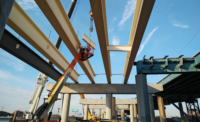Taking advantage of substantially reduced work-zone traffic volumes from COVID-19 stay-at-home orders, many state departments of transportation are accelerating road and bridge projects already underway or scheduled for 2020.
But there’s growing concern that any immediate benefits from fewer vehicles on the road won't make up for the expected loss of millions of dollars in fuel-tax revenue.
[For ENR’s latest coverage of the impacts of the COVID-19 pandemic, click here]
Agencies say the dearth of drivers allows them to undertake many projects that, in normal traffic conditions, would create or exacerbate congestion problems and present work zone risks for construction workers. Longer work windows allowed by the pandemic also help contractors incorporate health and safety practices to prevent the spread of COVID-19, including social distancing and more frequent disinfecting of equipment.
“These measures can affect contractors’ efficiency on these projects, but the trade-off is that they’re keeping people employed and improving infrastructure to help the economy rebound,” observes Rich Juliano, general counsel for the American Road and Transportation Builders Association.
Florida is among the most aggressive states opting to fast-forward projects, announcing in early April that it would accelerate $2.1 billion worth of statewide work by as much as four weeks. Projects include the new $864-million Howard Frankland Bridge across Old Tampa Bay, and the $802-million reconstruction of I-395/SR 836/I-95 in Miami. FDOT is also accelerating elements of the $2.3-billion I-4 Ultimate project in Orlando, being built by a joint venture of Skanska, Granite and Lane.
Scheduled maintenance on many California roads is likewise being fast-tracked.
A 70% drop in freeway traffic in the San Francisco Bay area has enabled Caltrans and contractor Myers & Son Construction to gain a three-month head start on a complicated deck replacement project at the U.S. 101/I-280 interchange. Longer daytime lane closures are helping speed up initial segments of Colorado DOT’s 10-mile $1.2-billion I-70 upgrade in Denver, being led by Kiewit Meridiam Partners.
Staggered 30-day closures of I-70’s east- and westbound lanes through downtown Indianapolis that began in early April will allow Milestone Contractors to complete eight months’ worth of work in the time frame, according to Indiana DOT spokesman Scott Manning, noting that the approach also eliminates the costs of implementing daily traffic control measures.
Additional IDOT projects could be accelerated in the coming months as reduced traffic volumes allow contractors to work more quickly. “This may allow for more contractor capacity later in the construction season, potentially allowing projects to happen that might have otherwise had to wait until next year,” Manning adds.
Although the Virginia DOT has yet to change its current procurement timeline, spokeswoman Emily Wade says the agency is evaluating contractors’ requests for greater flexibility in scheduling lane closures on a case-by-case basis. The New Jersey DOT is following a similar approach, along with extending standard daytime and nighttime work hours.
Transit agencies also are making the most of lower passenger volumes. Service reductions have allowed Bay Area Rapid Transit to increase progress on a rail replacement project by a factor of five, while Washington, D.C.’s regional Metrorail system recently added more stations to a planned summer-long platform reconstruction program.
Fuel Tax Revenue Dries Up
While DOTs may gain time with expedited road work, the hit to their budgets is just beginning, with several months’ worth of fuel-tax revenue already gone for good.
“People who aren’t driving now won’t drive twice as much to make up for it,” says Jim Tymon, American Association of State Highway and Transportation Officials executive director.
Not all DOTs will be affected equally by revenue losses, he says, but some already predict dire consequences.
Washington, one of the first states to restrict non-essential travel, predicts monthly revenue losses of $100 million, according to a state DOT letter to the state’s Congressional delegation. Missouri DOT projects a 30% decline in transportation revenue over the next 18 months, totaling nearly $1 billion.
North Carolina’s DOT, which only recently regained its fiscal footing following multiple weather-related repair and recovery efforts, finds itself facing a $300-million budget shortfall that has put nearly 50 major projects on hold, including a $77.5-million widening and interchange improvement project on I-95, and a new toll bridge to the Outer Banks barrier islands.
AASHTO and other industry groups are pressing Congress to enact a proposed $50-billion flexible funding bill to help states offset 2020 revenue losses. But as with the accelerated construction work now underway, such a measure would do little to address DOTs’ looming long-term funding problems.
Given that fully restored traffic counts are likely months or even years away, Juliano says enacting a multi-year successor to the expiring FAST Act funding bill has never been more important.
“We don’t want the short-term solution to come at the expense of the long-term solution,” he says.





